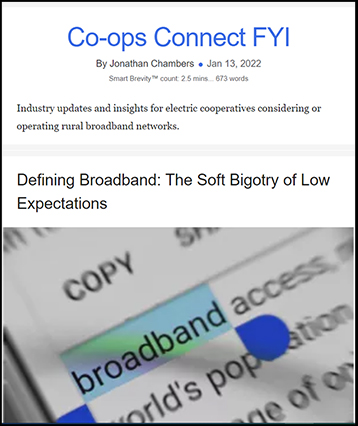Defining Broadband: The Soft Bigotry of Low Expectations
January 14, 2022
Remember last week’s takeaway:
Industry updates and insights for electric cooperatives considering or operating rural broadband networks.Federal and state governments have spent nearly $100 billion on rural broadband over the past decade, but we still have the same number of unserved households.
How can that be? Because the demand for broadband continues to outpace government definitions of broadband.
- Government programs have consistently funded broadband as a minimum service level.
- Definitions are typically out of date before the money is spent.
Broadband definitions matter. Funding programs use definitions to determine:
- Geographic areas eligible for assistance. Unserved or underserved areas may receive financial support. The broadband definition determines where the money goes.
- The level of service that must be provided with public funds.
These definitions are not necessarily two sides of the same coin.
A program might define unserved as lacking 25/3 Mbps, but at the same time require gigabit-capable networks be built to receive public funding.
The problem with government definitions
Broadband is not a speed.
The FCC currently uses multiple speed tiers to define broadband for funding purposes:
— 4/1 Mbps
— 10/1 Mbps
— 25/3 Mbps
— 25/5 Mbps
— 50/10 Mbps
— 100/20 Mbps
— 1 Gbps/500 Mbps
- These speed tier “definitions” are not related to current or projected demand for broadband.
- They are derived from the limitations of specific transmission technologies: copper (DSL), spectrum (fixed wireless and satellite), and coaxial cable.These speed tiers were created to allow inferior technologies access to public funds. What is known in the government as “technological neutrality” is a lobbying phrase. None of the government definitions of broadband are based on a neutral technology standard.
- A classic example of government waste:
- In 2015, the FCC defined broadband as 25/3 Mbps and committed $10 billion to large telephone companies to deliver only 10/1 Mbps in their rural service territories.
- Why 10/1? Because the telephone industry told the FCC that their copper networks could not handle faster speeds in rural areas.
- Then, in 2020 for the RDOF auction, the FCC defined unserved areas as those lacking 25/3 Mbps, specifically those areas where the large telephone companies were being paid to offer 10/1 Mbps.
The result: the FCC spent $10 billion in public funds on service it did not consider broadband, only to fund the exact same areas five years later with another $10 billion.
Bottom line: In this manner, the FCC and other government agencies spent $100 billion while the digital divide grew.
Has the federal government learned?
Short answer: No.
- While the Biden Administration’s initial policy position favored the only known future-proof transmission medium – fiber — Congress, the FCC and other federal agencies continue to define broadband as it existed yesterday, not as it will be tomorrow.
- Two-thirds of our customers already subscribe to speed tiers higher than any federal or state definition of broadband.
What we can expect: The Infrastructure Act is sending two-thirds of the broadband funding to states.
- How the states define broadband will now determine the future of broadband availability in rural America.
- If a federal or state agency is using speed as its broadband criterion, it is already out-of-date. Different policymakers; the same mistakes.
Those spending the public’s money on broadband programs should listen
1) To experts: Fund fiber only.
Fiber is, hands down, the most cost-efficient investment in broadband.
If an experienced and qualified entity is willing to build a fiber network in any unserved or underserved area, fund that.
2) To the public: Fund consumer choice.
Identify high-cost, underserved areas and provide a portable subsidy for broadband.
A pocketbook decision is better: Let consumers decide whether the service meets their needs.
3) To the future: Fund only long-term infrastructure.
Public funds should only be used to fund assets with a 30+ year life.
Final Thought
All across the country, electric cooperative networks, financed over 80 years ago with low-interest loans, are still serving rural communities. Those were good investments.
The bottom line: In a TikTok world, do we have the patience to fund long-term infrastructure?
